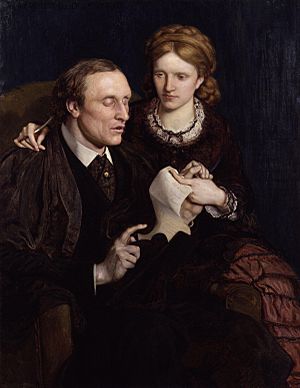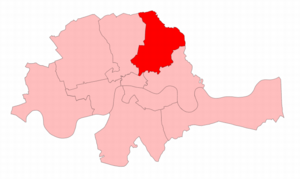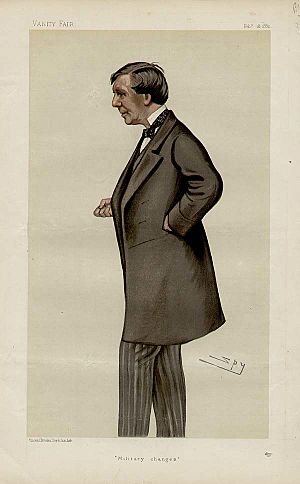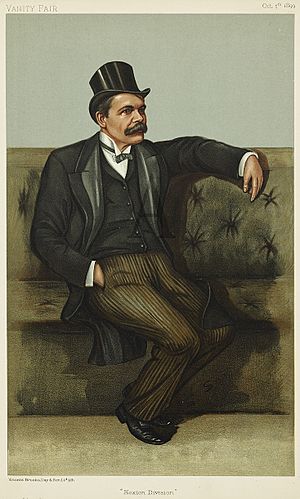Hackney (UK Parliament constituency) facts for kids
Quick facts for kids {{{Name}}}[[{{{Type}}} constituency]] |
|
|---|---|
| [[Image:{{{Map1}}}Constituency.svg|120px|]] [[Image:England{{{Map2}}}.svg|120px|]] |
|
| {{{Name}}} shown within [[{{{Entity}}}]], and {{{Entity}}} shown within England | |
| Created: | {{{Year}}} |
| MP: | {{{MP}}} |
| Party: | {{{Party}}} |
| Type: | House of Commons |
| County: | [[{{{County}}}]] |
| EP constituency: | [[{{{EP}}} (European Parliament constituency)|{{{EP}}}]] |
Hackney was a special area in London that used to elect two people to the UK Parliament. This area was called a "constituency." It was created in 1868 and lasted until 1885.
During its time, the Hackney constituency always elected two members from the Liberal Party. This happened in three general elections. By 1885, many new houses and apartments had been built in Hackney. Because of this growth, the area was split into seven smaller constituencies.
Contents
What were the boundaries of Hackney?
The area known as Hackney became a local government authority in 1855. This meant it had its own local council.
Where was the Hackney parliamentary borough located?
The parliamentary borough of Hackney was set up in 1868. It was in the eastern part of the historic county of Middlesex. This area included three main parishes:
- The Parish of St Leonard, Shoreditch
- The Parish of St Matthew, Bethnal Green
- The Parish of St John, Hackney
This area was the northern part of what used to be the Tower Hamlets parliamentary area. Hackney was located east of Islington and Hornsey, south of Tottenham, and west of Walthamstow in Essex.
In 1885, the Hackney constituency, which had two elected members, was closed down. A few years later, in 1889, the area became part of the London County Council. This was a new local government for London. Then, in 1900, the main local council for Hackney was replaced by the Metropolitan Borough of Hackney. This new borough had the same boundaries as the old parliamentary area. Since 1965, Hackney has been part of Greater London.
Who were the Members of Parliament for Hackney?
The people elected to represent Hackney in Parliament were called Members of Parliament, or MPs. All the MPs for Hackney were from the Liberal Party.

Here are the MPs who represented Hackney:
| Election | First Member | First Party | Second Member | Second Party | ||
|---|---|---|---|---|---|---|
| 1868 | Sir Charles Reed | Liberal | John Holms | Liberal | ||
| 1874 by-election | Henry Fawcett | Liberal | ||||
| 1884 by-election | James Stuart | Liberal | ||||
| 1885 | The constituency was closed down. New constituencies were created: Hackney North, Hackney Central and Hackney South. | |||||
How did elections work in Hackney?
In elections where two members were chosen, people could vote for two candidates. The "turnout" (how many people voted) was estimated by dividing the total votes by two. If people didn't use both their votes, the turnout might seem lower than it actually was.
Election Results in the 1860s
In the General Election of 1868, Hackney elected two Liberal MPs. Sir Charles Reed received 14,785 votes, and John Holms received 12,243 votes.
Election Results in the 1870s
In the General Election of 1874, John Holms and Charles Reed were re-elected as Liberal MPs. However, this election was later declared invalid.
A special election, called a by-election, was held on April 25, 1874. In this by-election, John Holms was re-elected, and Henry Fawcett became the new Liberal MP for Hackney.
Election Results in the 1880s
In the General Election of 1880, Henry Fawcett and John Holms were both re-elected as Liberal MPs.
Later in 1880, another by-election was held. This happened because Henry Fawcett became the Postmaster General and John Holms became a Lord Commissioner of the Treasury. They were both re-elected without anyone else running against them.
When Henry Fawcett passed away, another by-election was held on November 20, 1884. James Stuart won this election, becoming the new Liberal MP for Hackney.





